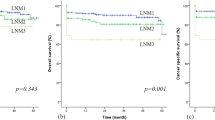Abstract
Background
Regional lymphadenectomy is recommended for all colon carcinoids, whereas resection without lymphadenectomy is accepted for selected appendiceal and rectal carcinoids. We examined the relation of tumor size and depth to lymph node metastasis in order to determine whether colon carcinoids could be selected for endoscopic resection.
Methods
Patients were identified from the Surveillance Epidemiology and End Results Registry. The Pearson chi-square and the log rank tests were used. P < 0.05 was considered significant.
Results
We identified 929 patients who underwent resection of localized colon carcinoids without distant metastasis diagnosed from 1973 to 2006. The diagnosis of small and superficial tumors increased over time (p < 0.001). The presence of lymph node metastasis was adversely associated with survival (p < 0.001); however, there was only a trend toward independence on multivariate analysis (p = 0.054). Tumor size and depth were associated with lymph node metastasis (p < 0.001, p < 0.001). Tumors were subgrouped by size and depth to find cases with a low risk of lymph node metastasis. Intramucosal tumors < 1 cm had a 4% rate of lymph node metastasis, while all other subgroups had rates ≥14%.
Conclusion
Tumor size and depth predict lymph node metastasis for colon carcinoids. Endoscopic resection may be appropriate for intramucosal tumors <1 cm.




Similar content being viewed by others
References
Modlin IM, Lye KD, Kidd M. A 5-decade analysis of 13,715 carcinoid tumors. Cancer 2003 Feb 15;97(4):934–59.
Williams ED, Sandler M. The classification of carcinoid tumours. Lancet 1963 Feb 2;1(7275):238–9.
Gustafsson BI, Kidd M, Modlin IM. Neuroendocrine tumors of the diffuse neuroendocrine system. Curr Opin Oncol 2008 Jan;20(1):1–12.
Pinchot SN, Holen K, Sippel RS, Chen H. Carcinoid tumors. Oncologist 2008 Dec;13(12):1255–69.
Yao JC, Hassan M, Phan A, Dagohoy C, Leary C, Mares JE, Abdalla EK, Fleming JB, Vauthey JN, Rashid A, Evans DB. One hundred years after “carcinoid”: epidemiology of and prognostic factors for neuroendocrine tumors in 35,825 cases in the United States. J Clin Oncol 2008 Jun 20;26(18):3063–72.
Ellis L, Shale MJ, Coleman MP. Carcinoid tumors of the gastrointestinal tract: trends in incidence in England since 1971. Am J Gastroenterol 2010 Dec;105(12):2563–9.
Maggard MA, O'Connell JB, Ko CY. Updated population-based review of carcinoid tumors. Ann Surg 2004 Jul;240(1):117–22.
Spread C, Berkel H, Jewell L, Jenkins H, Yakimets W. Colon carcinoid tumors. A population-based study. Dis Colon Rectum 1994 May;37(5):482–91.
Rosenberg JM, Welch JP. Carcinoid tumors of the colon. A study of 72 patients. Am J Surg 1985 Jun;149(6):775–9.
Ballantyne GH, Savoca PE, Flannery JT, Ahlman MH, Modlin IM. Incidence and mortality of carcinoids of the colon. Data from the Connecticut Tumor Registry. Cancer 1992 May 15;69(10):2400–5.
Plöckinger U, Rindi G, Arnold R, Eriksson B, Krenning EP, de Herder WW, Goede A, Caplin M, Oberg K, Reubi JC, Nilsson O, Delle Fave G, Ruszniewski P, Ahlman H, Wiedenmann B. Guidelines for the diagnosis and treatment of neuroendocrine gastrointestinal tumours. A consensus statement on behalf of the European Neuroendocrine Tumour Society (ENETS). Neuroendocrinology 2004;80(6):394–424.
NCCN Neuroendocrine Tumors Panel. Neuroendocrine Tumors. NCCN Clinical Practice Guidelines in Oncology. 201. v.1.2011 Available: http://www.nccn.org/professionals/physician_gls/pdf/neuroendocrine.pdf
Ramage JK, Davies AH, Ardill J, Bax N, Caplin M, Grossman A, Hawkins R, McNicol AM, Reed N, Sutton R, Thakker R, Aylwin S, Breen D, Britton K, Buchanan K, Corrie P, Gillams A, Lewington V, McCance D, Meeran K, Watkinson A. Guidelines for the management of gastroenteropancreatic neuroendocrine (including carcinoid) tumours. Gut 2005 Jun;54 Suppl 4:iv1-16
Bernick PE, Klimstra DS, Shia J, Minsky B, Saltz L, Shi W, Thaler H, Guillem J, Paty P, Cohen AM, Wong WD. Neuroendocrine carcinomas of the colon and rectum. Dis Colon Rectum 2004 Feb;47(2):163–9.
Kaplan EL, Meier P. Nonparametric estimation from incomplete observations. J Am Stat Assoc 1958; 53:457–62
Landry CS, Brock G, Scoggins CR, McMasters KM, Martin RC 2nd. Proposed staging system for colon carcinoid tumors based on an analysis of 2,459 patients. J Am Coll Surg 2008 Dec;207(6):874–81.
Bentrem DJ, Okabe S, Wong WD, Guillem JG, Weiser MR, Temple LK, Ben-Porat LS, Minsky BD, Cohen AM, Paty PB. T1 adenocarcinoma of the rectum: transanal excision or radical surgery? Ann Surg 2005 Oct;242(4):472–7.
Solcia E, Solcia E, Klöppel G, Sobin LH, Capella C, DeLellis RA, Heitz PU, Horvath E, Kovacs K, Lack E, Lloyd RV, Rosai J, Scheithauer BW. Histopathological typing of endocrine tumors. World Health Organisation international histological classification of tumors. Berlin, Heidelberg: Springer-Verlag 2000; 61–68
Acknowledgement
This work was supported by the Department of Veterans Affairs Office of Research and Development through a Career Development Award-2 (JSG).
Author information
Authors and Affiliations
Corresponding author
Additional information
Presented in part at the Association of VA Surgeons Annual Meeting, Indianapolis, IN, December 2010.
Rights and permissions
About this article
Cite this article
Al Natour, R.H., Saund, M.S., Sanchez, V.M. et al. Tumor Size and Depth Predict Rate of Lymph Node Metastasis in Colon Carcinoids and Can Be Used to Select Patients for Endoscopic Resection. J Gastrointest Surg 16, 595–602 (2012). https://doi.org/10.1007/s11605-011-1786-1
Received:
Accepted:
Published:
Issue Date:
DOI: https://doi.org/10.1007/s11605-011-1786-1




